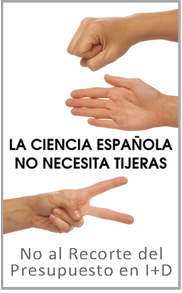Archive for the ‘Mundo Freak’ Category
GTCA, la Segunda Parte de «The PCR Song»
Creo que a esto es a lo que se le llama Marketing Viral, uno hace un anuncio en formato vídeo-friki y la gente se lo reenvía, lo publica en blogs etc…la empresa no se gasta un duro en publicitarlo y quedan como empresa salá donde las haya. Bio-Rad ya consiguió un exitazo con The PCR Song, y han vuelto a la carga con GTCA:
Por lo menos en el laboratorio nos hemos echado unas risas, y al final, siempre se compra lo que funciona y sale barato…
El Famoso Paper de Caperucita y el Lobo Feroz
Hace ya un tiempo que me mandaron un correo con este artículo, por aquellos entonces no tenía un blog donde colgar todas estas cosas y cuando empecé con Sonicando, desapareció el artículo. Hoy lo tenéis gracias a Ernesto, un estudiante que hizo una estancia en nuestro laboratorio y que se ha pegao el detallazo de mandármelo al correo.


El artículo entero lo podéis descargar aquí : [paper_de_caperucita]
Cómo Escribir un Artículo Científico (Humor)
No me preguntéis qué link llevo a otro link que… dando una vueltecilla por internet, me he tropezado con Eric Schulman’s Science Humor Webpage, la página web de un señor que por lo visto se ha dedicado a lo grande a escribir de ciencia, pero en plan cachondeo.
Hoy os cuelgo «How to Write a Scientific Paper«, que no tiene desperdicio
1. Introduction
Scientific papers (e.g., Schulman 1988; Schulman & Fomalont 1992; Schulman, Bregman, & Roberts 1994; Schulman & Bregman 1995; Schulman 1996) are an important–though poorly understood–method of publication. They are important because without them scientists cannot get money from the government or from universities. They are poorly understood because they are not written very well (see, for example, Schulman 1995 and selected references therein). An excellent example of the latter phenomenon occurs in most introductions, which are supposed to introduce the reader to the subject so that the paper will be comprehensible even if the reader has not done any work in the field.
The real purpose of introductions, of course, is to cite your own work (e.g., Schulman et al. 1993a), the work of your advisor (e.g., Bregman, Schulman, & Tomisaka 1995), the work of your spouse (e.g., Cox, Schulman, & Bregman 1993), the work of a friend from college (e.g., Taylor, Morris, & Schulman 1993), or even the work of someone you’ve never met, as long as your name happens to be on the paper (e.g., Richmond et al. 1994). Note that these citations should not be limited to refereed journal articles (e.g., Collura et al. 1994), but should also include conference proceedings (e.g., Schulman et al. 1993b), and other published or unpublished work (e.g., Schulman 1990).
At the end of the introduction you must summarize the paper by reciting the section headings. In this paper, we discuss scientific research (section 2), scientific writing (section 3), scientific publication (section 4), and draw some conclusions (section 5).
2. Scientific Research
The purpose of science is to get paid for doing fun stuff (Schulman et al. 1991). Nominally, science involves discovering something new about the Universe, but this isn’t really necessary. What is really necessary is a grant. In order to obtain a grant, your application must state that the research will discover something incredibly fundamental. The grant agency must also believe that you are the best person to do this particular research, so you should cite yourself both early (Schulman 1994) and often (Schulman et al. 1993c). Feel free to cite other papers as well (e.g., Blakeslee et al. 1993; Levine et al. 1993), so long as you are on the author list.
Once you get the grant, your university, company, or government agency will immediately take 30 to 70% of it so that they can heat the building, pay for Internet connections, and purchase large yachts.
Now it’s time for the actual research. You will quickly find out that (a) your project is not as simple as you thought it would be and (b) you can’t actually solve the problem. However — and this is very important — you must publish anyway (Schulman & Bregman 1994).
3. Scientific Writing
You’ve spent years on a project and have finally discovered that you can’t solve the problem you set out to solve. Nonetheless, you have a responsibility to present your research to the scientific community (Schulman et al. 1993d). Be aware that negative results can be just as important as positive results, and also that if you don’t publish enough you’ll never be able to stay in science.
While writing a scientific paper, the most important thing to remember is that the word «which» should almost never be used. Be sure to spend at least 50% of your time (i.e., 12 hours a day) typesetting the paper so that all the tables look nice (Schulman & Bregman 1992).
4. Scientific Publishing
You’ve written the paper, and now it’s time to submit it to a scientific journal. The journal editor will pick the referee most likely to be offended by your paper, because then at least the referee will read it and get a report back within the lifetime of the editor. Referees who don’t care one way or the other about a paper have a tendency to leave manuscripts under a growing pile of paper until the floor collapses, killing the 27 English graduate students who share the office below (Schulman, Cox, & Williams 1993).
Be aware that every scientific paper contains serious errors. If your errors are not caught before publication, you’ll eventually have to write an erratum to the paper explaining (a) how and why you messed up and (b) that even though your experimental results are now totally different, your conclusions need not be changed. Errata can be good for your career. They are easy to write, and the convention is to reference them as if they were real papers, leading the casual reader–and perhaps also the Science Citation Index–to think that you’ve published more papers than you really have (Schulman et al. 1994).
5. Conclusions
The conclusion section is very easy to write: all you have to do is to take your abstract and change the tense from present to past. It’s considered good form to mention at least one relevant theory only in the abstract and conclusion. By doing this, you don’t have to say why your experiment does (or does not) agree with the theory, you merely have to state that it does (or does not).
We (meaning I) presented observations on the scientific publishing process which (meaning that) are important and timely in that unless I have more published papers soon, I will never get another job. These observations are consistent with the theory that it is difficult to do good science, write good scientific papers, and have enough publications to get future jobs.
Me hubiera gustado tener a mano el artículo científico de Caperucita Roja, pero mira que lo he buscado estos días y me temo que lo he perdido…
Aprenda Inmunología en VHS
Si hay algo que aprendimos en el instituto es que se tarda mucho menos alquilando la película en el videoclub, que leyéndose el libro entero para el examen, otra cosa era aprobar…
El youtube es un verdadero filón, así que para que hablar del sistema inmunológico, si os lo pueden enseñar en este maravilloso vídeo musical…
Algún día me perdonaréis por esto…
Welcome Image Awards
Os dejo el Link y una foto (pa que os hagáis una idea), de la página de estos curiosos premios.La foto es una microscopía electrónica de barrido de una célula cancerígena (de cancer de mama)

Si es que hay fotos que quedan para exponer en museo…a ver si me dan permiso (aun no está publicada) y subo una que hice el otro día.












